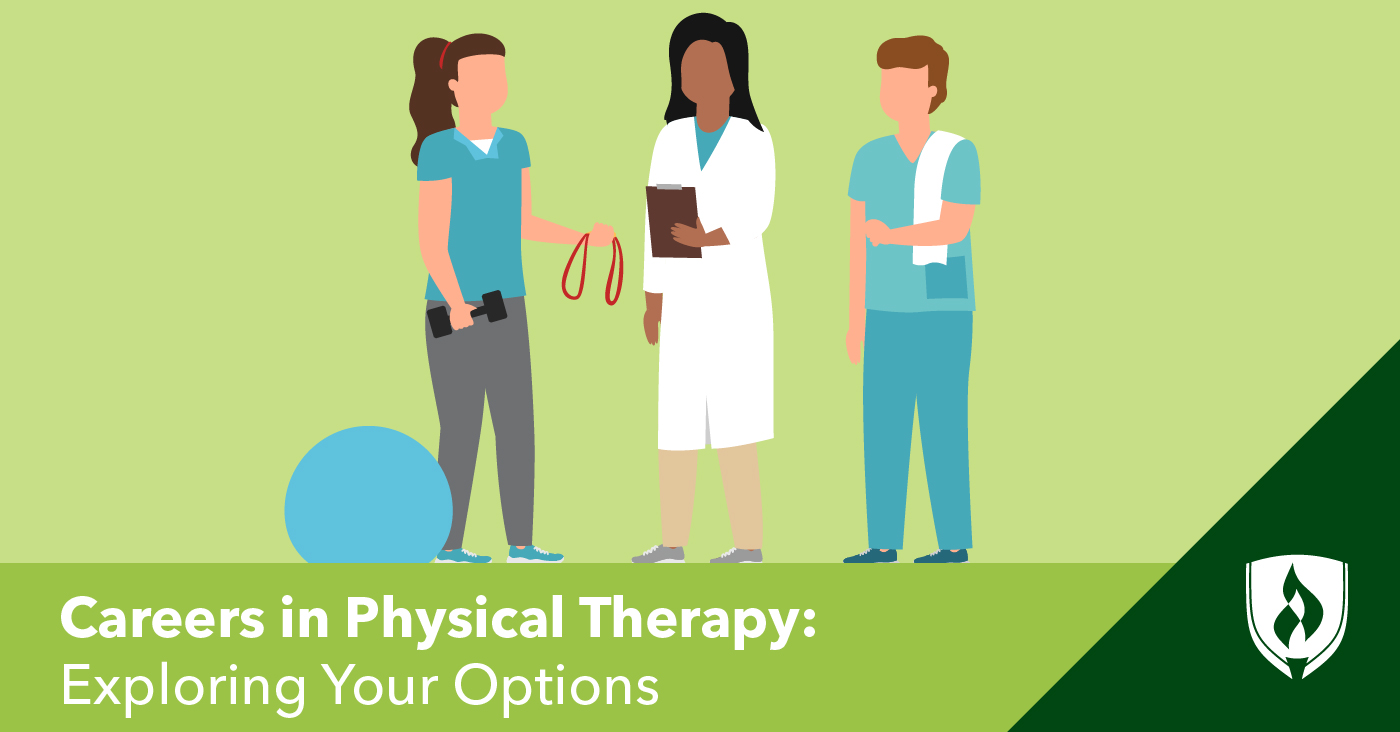
A remarkable thing about humanity is our ability to look adversity right in the face and overcome it. You can see this so clearly in the stories of individuals who experience debilitating injury or disease and undergo the long process of rehabilitation. This day-by-day struggle is inspiring, as the individual has the choice before them every day to give up, yet they choose to press on.
While these stories speak to the strength of the human spirit, they also speak to the power of community and the people that help others when they are at their lowest. Some of the most important members of this support community belong to the world of physical therapy.
Physical therapists (PTs), physical therapist assistants (PTAs) or physical therapist aides all play a part: from diagnosing the issue and charting the path to recovery to helping with the day-to-day grind of rehabilitative work.
These careers in physical therapy can offer you an opportunity to play a role in human flourishing and also a rewarding way to earn a living. Could this be the right field for you? Read on to learn more about some of the potential pathways to working in physical therapy.
Making sense of physical therapy roles
Within the physical therapy world, you’ll find three main roles: The physical therapist, the physical therapy assistant and the physical therapy aide. Let’s take a closer look at each of them.
1. Physical therapist
As a baseline, the role of a physical therapist involves helping injured or ill people improve movement and manage pain. PTs work within the healthcare system by interacting with medical personnel and using knowledge of a patient’s medical history to develop individualized plans of care to work with a patient. They create a plan and begin the step-by-step process of recovery with their patient, sometimes quite literally at their side.
To become a PT, you’ll need a bachelor’s degree before earning a Doctor of Physical Therapy (DPT), a graduate program that typically takes two to three years to complete.1 Additionally, you’ll need to pass a national licensure exam and fulfill all other state licensure requirements.
The Bureau of Labor Statistics (BLS) reports that employment of physical therapists is projected to increase by 21 percent from 2020 through 2030, a growth projection much faster than the national average for other occupations.2
2. Physical therapist assistant
A physical therapist assistant reports directly to a supervising physical therapist. This hands-on role involves patient observation, documentation of progress, and assisting and coaching patients as they work through the specific rehabilitative plan assigned by the PT.
To become a PTA, you’ll need an associate’s degree. These programs typically take about two years to complete, and the Rasmussen University Physical Therapist Assistant program can be completed in as few as 18 months.1 Similar to PTs, you’ll also need to pass a licensure exam and fulfill all other state PTA licensure requirements to practice in this role.
Also like PTs, these physical therapy professionals appear to be in high demand. The BLS projects employment of physical therapist assistants to grow 35 percent from 2020 to 2030.2
3. Physical therapy aide
Physical therapy aides are support staff that work under both PTs and PTAs. They generally are in charge of cleaning treatment areas, washing linens, helping a PT or PTA move a patient and doing clerical work around the office.
To become a physical therapy aide, a high school diploma is all that is required. This accessible option makes it a great starting point for prospective PTs and PT assistants looking to build experience and establish connections in the field.
The BLS projects a 25 percent increase in employment for physical therapy aides from 2020 through 2030.2
If you are looking for a more in-depth comparison between a physical therapy assistant and aide, check out, Physical Therapy Aide vs. Assistant: Examining the Differences.
Specializations in physical therapy
The world of physical therapy goes beyond the roles described above. If you choose to pursue a career in physical therapy, there are a wide variety of focuses you can pursue to specialize in specific areas. These areas offer professionals in physical therapy the chance to work with the populations and environments that most fascinate them. Here are the ten certifications offered by the American Physical Therapy Association (APTA)®:
1. Cardiovascular and Pulmonary
PTs with a cardiovascular and pulmonary focus help individuals who have struggled with issues like heart attacks, COPD, pulmonary fibrosis and the complications associated with them.
2. Clinical Electrophysiology
Electrophysiology is the study of the electrical properties of cells and tissues. PTs with a clinical electrophysiologic approach use medical technology to apply electricity to help patients recover.
3. Geriatrics
Geriatric PTs have a special focus on working with the needs of aging adults. Most often, geriatric PTs focus on patients dealing with issues like arthritis, osteoporosis, joint replacements or various types of balance disorders.
4. Neurology
PTs with a neurology focus work with individuals who have problems related to a disease or injury connected with the nervous system. These PTs will commonly work with strokes, brain injuries or spinal cord injuries.
5. Oncology
Oncology PTs work with patients struggling with the effects of cancer and its treatments.
6. Orthopedics
Orthopedic PTs work with individuals who have disorders or dysfunction within the musculoskeletal system. These PTs will commonly work with issues like arthritis, muscle weakness/imbalance or tendonitis.
7. Pediatrics
Pediatric PTs specialize in working with children. From newborns to teenagers, pediatric PTs help kids develop their range of motion, flexibility and strength.
8. Sports
Sport PTs focus their work on athletes who are recovering from injury and trying to return to full performance. Sport PTs typically work for professional teams, schools or healthcare/rehabilitation centers.
9. Women’s Health
PTs with a focus in women’s health help women deal with issues connected to pregnancy, menopause and other conditions unique to women.
10. Wound Management
Wound management PTs focus specifically on injuries that break the skin/tissue by developing a plan to help an individual recover from this open injury.
Is physical therapy for you?
The field of physical therapy is rife with opportunities and specialties. Whether you are looking to become a physical therapist or a physical therapist assistant, the world of physical therapy offers stability and a career centered on helping others. If you are curious about the next steps to take to pursue a career as a physical therapist assistant, check out "How to Become a Physical Therapist Assistant (and Why You Should).”
1Completion time is dependent on the number of transfer credits accepted and the number of courses completed each term.
2Bureau of Labor Statistics, U.S. Department of Labor, Occupational Outlook Handbook, [information accessed July 2022] www.bls.gov/ooh/. Employment conditions in your area may vary.
APTA is a registered trademark of American Physical Therapy Association, Inc.




